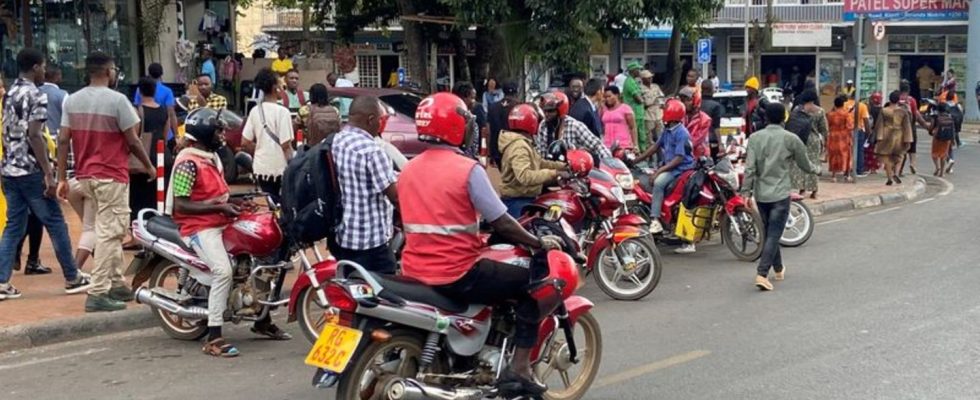Environment
Invisible Danger: Africa’s Fight Against Air Pollution
Traffic in Kigali city center. There are an estimated 30,000 motorcycle taxi drivers in the capital of Rwanda. photo
© David Renke/dpa
According to the UN, air pollution in Africa’s cities has become an “invisible danger”. Traffic in particular will pollute the air in the future. E-mobility should help. That’s not enough, researchers warn.
Business people especially enjoy driving with Albert Nzigirimana. “They like that the ride is very smooth and there is no jerking when switching gears,” says the mid-forties. Nzigirimana is one of the estimated 30,000 motorcycle taxi drivers in Rwanda’s capital Kigali. He has been riding an electric motorcycle for a year.
Every day, Nzigirimana drives customers through Kigali in his vehicle – Moto for short – and is an alternative to expensive taxis and overcrowded buses. Motorcycle taxis are an integral part of public transport almost everywhere in sub-Saharan Africa. Nzigirimana and his e-bike are instantly recognizable by the bright yellow battery installed in front of the bikes’ seat. He is still one of the few drivers who have already switched to e-mobility.
With the soaring gasoline prices, e-motorcycles have become profitable competition for gasoline-powered vehicles, says Nzigirimana. For him, however, another reason was decisive for switching to an e-moto: “If you’ve been riding a moto for years, the exhaust gases put a strain on your lungs,” says Nzigirimana. He also suffers from breathing problems. He is by no means the only motorcyclist complaining of health problems: According to British researchers, more and more riders are suffering from respiratory diseases or skin and eye irritation as a result of the toxic exhaust gases.
In Africa’s cities, these have long been a major problem. The UN recently described air pollution in the continent’s metropolises as an “invisible danger”. According to the United Nations Environment Program (UNEP), the number of premature air pollution-related deaths in Africa could reach 1.6 million per year by 2063.
In no other part of the world apart from Asia are cities growing as fast as in Africa. In addition, Africa is the continent with the highest population growth ever. According to the Organization for Economic Co-operation and Development (OECD), by 2050 almost a billion people will move to cities in Africa. But they are already groaning under the avalanches of traffic that are clogging the completely inadequate road network in the cities.
Expert: Traffic major cause of air pollution
Ngongang Wandji Danube, expert on air quality management at the Stockholm Environment Institute Africa (SEI Africa) in Nairobi, looks with concern at this development ahead of the International Day of Clean Air on September 7: “Transport is one of the main reasons for the high level of air pollution in the African cities.”
Overall, indoor air pollution is still the most at risk on the continent, especially in rural areas, as many households still cook on open fires. However, according to scientists, the number of deaths from indoor air pollution is falling because the switch to gas stoves offers a quick fix to the problem. However, the risk of air pollution from traffic emissions is steadily increasing. The motorcycle taxis contribute a not inconsiderable part to the emissions in the cities.
Warning of polluting motorcycle taxis
Two years ago, Peter Anyang Nyong’o, the governor of Kisumu County in Kenya, warned of the environmental dangers of the Boda Bodas, as the motorcycle taxis are called there. “It is estimated that an average motorcycle emits ten times more pollutants per kilometer than a car, light truck or SUV,” said Anyang’ Nyong’o. Josh Whale, managing director of the Rwandan e-motorcycle manufacturer Ampersand, thinks the estimate is plausible: “Many of the motorcycles in Africa are not built to European emission standards, most not even to Indian standards, where many of the motorcycles used in Africa are built become.” Many of the bikes still perform with 1970s technology.
At the same time, the number of motorcycle taxis on Africa’s roads will continue to increase in the coming years. Not only are they a cheap alternative, they are also the only way to avoid getting stuck in traffic. Experts predict that the number of motorcycle taxis in Kenya’s capital, Nairobi, will more than triple to around five million by 2030. According to experts, the number in Kigali is also likely to triple.
Rwanda wants to electrify a third of its motorcycles
For this reason, according to the UN development program, Rwanda wants to electrify almost a third of its motorcycles by 2030. This should not only make the air cleaner, but also reduce greenhouse gas emissions. However, this alone will not solve the problem, believes Carol Mungo, energy and climate expert at SEI Africa: “Unfortunately, the public transport system in Africa is not yet very advanced, so most people who can afford it inevitably opt for one own car.”
In addition, buses are a paradise for thieves and not always a safe means of transport for women. Local trains do not exist in most African metropolises. The bus lines often do not run according to a fixed timetable. Mungo is also convinced that well-developed local public transport with buses and trains would be the most climate-friendly and environmentally friendly solution.
Dar es Salaam, the largest city in Tanzania, shows how it could work. There has been one of the best public transport networks in sub-Saharan Africa for several years with an express bus network. Buses bypass the city’s congestion with their own lanes, making them much more reliable. The model is considered a role model for many cities in Africa. However, the price is high: so far, the expansion of public transport has cost around 350 million US dollars (321 million euros).

